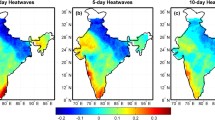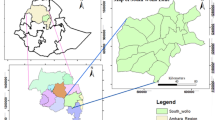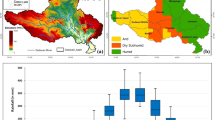Abstract
In the Indian Subcontinent, droughts occur generally due to delayed arrival or early retreat of the south-west monsoon associated with poor precipitation. However, initiation and intensification of droughts may also result from heat waves. With an arid to semi-arid climate, the Gujarat State of India experiences seasonal temperature variations and frequent heat waves during summer and inconsistent rainfall during the rainy (monsoon) season, resulting in recurrent droughts. In the present study, ground data of rainfall and temperature were used to assess meteorological drought in Gujarat during 1981–2010. Geographical information systems (GIS)-based analysis revealed an association between rainfall deficit and heat waves, and an indirect influence of heat waves and temperature extremes on drought development and intensification. The study indicates a relationship between climate extremes and climate change. It also points to the fact that, in certain years, local factors are more influential than global factors such as El Niño and the Southern Oscillation (ENSO) for drought occurrence and non-occurrence in Gujarat.









Similar content being viewed by others
References
ACD (2012) Annual report 2011–12, The Agriculture and Cooperation Department, Government of Gujarat. http://agricoop.nic.in/imagedefault/ARE2012.pdf. Accessed on 02.08.2014
Alexander LV, Zhang X, Peterson TC, Caesar J, Gleason B, Klein Tank AMG, Haylock M, Collins D, Trewin B, Rahimzadeh F, Tagipour A, Kumar KR, Revadekar J, Griffiths G, Vincent L, Stephenson DB, Burn J, Aguilar E, Brunet M, Taylor M, New M, Zhai P, Rusticucci M, Vazquez-Aguirre JL (2006) Global observed changes in daily climate extremes of temperature and precipitation. J Geophys Res Atmos 111:05109
Bandyopadhyay N, Bhuiyan C, Saha AK (2015) Temperature extremes, moisture deficiency and their impacts on dryland agriculture in Gujarat, India. In: Andreu J, Solera A, Paredes-Arquiola J, Haro-Monteagudo D, van Lanen H (eds) Drought: research and science-policy interfacing. CRC Press, UK
Barriopedro D, Fischer EM, Luterbacher J, Trigo RM, García-Herrera R (2011) The hot summer of 2010: redrawing the temperature record map of Europe. Science 332:220–224
Bhuiyan C (2004) Various drought indices for monitoring drought condition in Aravalli terrain of India. In: Proceedings of the XXth ISPRS congress, Int Soc Photogramme, Istanbul
Bhuiyan C (2008) Desert vegetation during droughts: response and sensitivity. In: Proceedings of the XXIth ISPRS congress, Int Soc Photogramme, Beijing
Bhuiyan C, Kogan FN (2010) Monsoon variation and vegetative drought patterns in the Luni Basin under rain-shadow zone. Int J Remote Sens 31(12):3223–3242
Bhuiyan C, Singh RP, Kogan FN (2006) Monitoring drought dynamics in the Aravalli terrain (India) using different indices based on ground and remote sensing data. Int J Appl Earth Obs 8:289–303
Blair TA (1931) Relations between winter temperature and precipitation. Mon Weather Rev 59:34–55
Census of India (2011) Population enumeration data, Government of India. http://www.censusindia.gov.in/2011census/population_enumeration.html. Accessed on 01.04.2015
Chaudhury SK, Gore JM, Sinha Ray KC (2000) Impact of heat waves over India. Curr Sci India 79:153–155
Ciais P, Reichstein M, Viovy N, Granier A, Ogée J, Allard V, Aubinet M, Buchmann N, Bernhofer C, Carrara A, Chevallier F, Noblet ND, Friend AD, Friedlingstein P, Greunwald T, Heinesch B, Keronen P, Knohl A, Krinner G, Loustau D, Manca G, Matteucci G, Miglietta F, Ourcival JM, Papale D, Pilegaard K, Rambal S, Seufert G, Soussana JF, Sanz MJ, Schulze ED, Vesala T, Valentini R (2005) Europe-wide reduction in primary productivity caused by the heat and drought in 2003. Nature 437:529–533
Dai A, Trenberth KE, Qian T (2004) A global data set of Palmer drought severity index for 1870–2002: relationship with soil moisture and effects of surface warming. J Hydrometeorol 5:1117–1130
De US, Mukhopadhyay RK (1998) Severe heat wave over Indian subcontinent in 1998 in a perspective of global climate. Curr Sci India 75:1308–1311
De US, Dube RK, Prakasa Rao GS (2005) Extreme weather events over India in the last 100 years. J Indian Geophys Union 9(3):173–187
Donat MG, Alexander LV, Yang H, Durre I, Vose R, Caesar J (2013) Global land-based datasets for monitoring climatic extremes. Bull Am Meteorol Soc 94:997–1006
Edwards DC, McKee TB (1997) Characteristics of 20th century drought in the United States at multiple time scales. Climatology report number 97–2, Colorado State University, Fort Collins, pp 1–155
EM-DAT (2011) OFDA/CRED international disasters database. http://www.em-dat.net. Accessed on 20.04.2014
European Space Agency (2015) http://www.esa.int/Our_Activities/Observing_the_Earth/Space_for_our_climate/Hot_and_dry_but_why. Accessed on 21.09.2014
Fischer ML, Torn MS, Billesbach DP, Doyle G, Northup B, Biraud SC (2012) Carbon, water, and heat flux responses to experimental burning and drought in a tallgrass prairie. Agric For Meteorol 166–167:169–174
Frich A, Alexander LV, Della-Marta P, Gleason B, Haylock M, Klein Tank AMG, Peterson T (2002) Observed coherent changes in climatic extremes during the second half of the twentieth century. Clim Res 19:193–212. doi:10.3354/cr019193
Gadgil S, Vinayachandran PN, Francis PA (2003) Droughts of the Indian summer monsoon: role of clouds over the Indian Ocean. Curr Sci 85(12):1713–1719
Giannini A, Biasutti M, Verstraete MM (2008) A climate model-based review of drought in the Sahel: desertification, the re-greening and climate change. Global Planet Change 64:119–128
Guttman NB (1998) Comparing the Palmer drought index and the standardized precipitation index. J Am Water Resour Assoc 34(1):113–121
Guttman NB (1999) Accepting the standardized precipitation index: a calculation algorithm. J Am Water Resour Assoc 35(2):311–322
Hagos SM, Cook KH (2008) Ocean warming and late-twentieth-century Sahel drought and recovery. J Clim 21:3797–3814. doi:10.1155/2011/259529
Hamrick AM, Martin HH (1941) Fifty years’ weather in Kansas, MO, 1989–1938. Mon Weather Rev 44(Supply):53
Hansen J, Sato M, Ruedy R (2012) Perception of climate change. Proc Natl Acad Sci USA. http://www.pnas.org/cgi/doi/10.1073/pnas.1205276109. Accessed on 20.04.2014
IMD (1971) Climate diagnostic bulletin of India—June, July, August, report no 88, 89 and 90. National Climate Center, India Meteorological Division, Pune
IMD1 (2015) http://www.imd.gov.in/section/nhac/dynamic/termglossary.pdf. Accessed on 12.08.2015
IMD2 (2015) http://www.imdpune.gov.in/weather_forecasting/glossary.pdf. Accessed on 21.12.2015
Jain V, Pandey R, Jain M, Byun HR (2015) Comparison of drought indices for appraisal of drought characteristics in the Ken River Basin. Weather Clim Extrem 8:1–11
Jayalakshmi K (2015) India: as heat wave claims hundreds of lives scientists predict more such events. http://www.ibtimes.co.uk/india-heat-wave-claims-hundreds-lives-scientists-predict-more-such-events-1502816. Accessed on 27.07.2015
Joseph PV, Eischeid JK, Pyle RJ (1994) Interannual variability of the onset of the Indian summer monsoon and its association with atmospheric features, El Niño, and sea surface temperature anomalies. J Climatol 7:81–105
Jung M, Reichstein M, Ciais P, Seneviratne SI, Sheffield J, Goulden ML, Bonan G, Cescatti A, Chen J, De Jeu R (2010) Recent decline in the global land evapotranspiration trend due to limited moisture supply. Nature 467(7318):951–954
Kalsi SR, Pareek RS (2001) Hottest April of the 21st century over northwest and central India. Curr Sci India 80(7):867–873
Khole M, De US (2001) Socio economic impacts of natural disasters. WMO Bull 50(1):35–40
Koster RD, Schubert SD, Suarez MJ (2009) Analyzing the concurrence of meteorological droughts and warm periods, with implications for the determination of evaporative regime. J Clim 22:3331–3341
Krishna Kumar K, Rupa Kumar K, Pant GB (1997) Pre-monsoon maximum and minimum temperatures over India in relation to the summer monsoon rainfall. Int J Clim 17:1115–1127
Kumar KK, Rajagopalan B, Cane AM (1999) On the weakening relationship between the Indian monsoon and ENSO. Science 284:2156–2159
Kumar MN, Murthy CS, Sesha Sai MVR, Roy PS (2009) On the use of standardized precipitation index (SPI) for drought intensity assessment. Meteorol Appl 16:381–389
Kumar R, Musuuza JL, Van Loon AF, Teuling AJ, Barthel R, Ten Broek J, Mai J, Samaniego L, Attinger S (2015) Multiscale evaluation of the standardized precipitation index as a groundwater drought indicator. Hydrol Earth Syst Sci Discuss 12:7405–7436
Madden RA, Williams J (1978) The correlation between temperature and precipitation in the United States and Europe. Mon Weather Rev 106:142–147
McKee TB, Doesken NJ, Kleist J (1993) The relation of drought frequency and duration to time scales. In: Proceedings of the eighth conference on applied climatology, Am Meteorol Soc Boston, pp 179–184
Meehl GA, Tebaldi C (2004) More intense, more frequent, and longer lasting heat waves in the 21st century. Science 305:994–997
Meyers TP (2001) A comparison of summertime water and CO2 fluxes over rangeland for well watered and drought conditions. Agric For Meteorol 106(3):205–214
Miralles DG, Teuling AJ, van-Heerwaarden CC, de-Arellano JVG (2014) Mega-heatwave temperatures due to combined soil desiccation and atmospheric heat accumulation. Nat Geosci 7:345–349
Mooley DA, Paolino DA (1988) A predictive monsoon signal in the surface level thermal field over India. Mon Weather Rev 116(1):256–264
Nicholls N, Della-Marta P, Collins D (2004) 20th century changes in temperature and rainfall in New South Wales. Aust Meteorol Mag 53:263–268
NOAA (2012) Late monsoon leads to drought in India. https://www.climate.gov/news-features/climate-current-events/late-monsoon-leads-drought-india. Accessed on 3. 2.2015
Parthasarathi B, Rupa Kumar K, Sontakke NA (1990) Surface and upper air temperatures over India in relation to monsoon rainfall. Theor Appl Clim 42:93–110
Peters E, Van Lanen H (2000) Activity “groundwater drought”. In: Hisdal H, Tallaksen L (eds.) Drought event definition, assessment of the regional impact of droughts in Europe, Technical report no. 6:31–31
Pearson K (1895) Notes on regression and inheritance in the case of two parents. Proc R Soc Lond 58:240–242
Planning Commission Report (2007) http://planningcommission.nic.in/reports/sereport/ser/stdy_droght.pdf. Accessed on 4.5.2015
Ray K, Mohanty M, Chincholikar JR (2012) Analysis of extreme high temperature conditions over Gujarat. Mausam 64:467–474
Russel WT (1922) The relationship between rainfall and temperature as shown by the correlation coefficient. Quart J R Meteorol Soc 48(203):225–233
Sarkar S, Singh RP, Kafators M (2004) Further evidences for the weakening relationship of Indian rainfall and ENSO over India. Geophys Res Lett 31(13), L13209. doi:10.1029/2004GL020259
Seneviratne SI, Nicholls N, Easterling D, Goodess CM, Kanae S, Kossin J, Luo Y, Marengo J, McInnes K, Rahimi M, Reichstein M, Sorteberg A, Vera C, Zhang X (2012) Changes in climate extremes and their impactson the natural physical environment. In: Field CB, Barros V, Stocker TF, Qin D, Dokken DJ, Ebi KL, Mastrandrea MD, Mach KJ, Plattner GK, Allen SK, Tignor M, Midgley PM (eds.) Managing the risks of extreme events and disasters to advance climate change adaptation. A special report of working groups I and II of the Intergovernmental Panel on Climate Change, pp 109–230
Shukla J, Paolino DA (1983) The Southern Oscillation and long range forecasting of the summer monsoon rainfall over India. Mon Weather Rev 111:1830–1837
Steffen W, Hughes L, Perkins S (2014) Heat waves: hotter, longer, more often. Climate Council of Australia Limited. http://www.climatecouncil.org.au/uploads/9901f6614a2cac7b2b888f55b4dff9cc.pdf. Accessed on 28.09.2015
Striem HL (1979) Some aspects of the relation between monthly temperatures and rainfall, and its use in evaluating earlier climates in the Middle East. Clim Change 2(1):69–74
Sun G, Noormets A, Chen J, McNulty SG (2008) Evapotranspiration estimates from eddy covariance towers and hydrologic modeling in managed forests in Northern Wisconsin, USA. Agric For Meteorol 148(2):257–267
Teuling AJ, Van Loon AF, Seneviratne SI, Lehner I, Aubinet M, Heinesch B, Bernhofer C, Grünwald T, Prasse H, Spank U (2013) Evapotranspiration amplifies European summer drought. Geophys Res Lett 40(10):2071–2075
The New York Times (1987) http://www.nytimes.com/1987/08/16/world/india-s-drought-is-worst-in-decades.html. Accessed on 01.08.2014
Trenberth KE, Shea DJ (2005) Relationship between precipitation and surface temperature. Geophys Res Lett 32:L14703. doi:10.1029/2005GL022760
Vora A, Parikh D (1996) Water management to combat drought. J Sardar Patel Inst Econ Soc Res Ahmedabad 26(2):33
Walker GT (1924) Correlation in seasonal variation of weather, application to seasonal forecasting in India. Mem India Meteorol Dept 24:333–345
Walker GT, Bliss EW (1937) World weather VI. Mem Meteorol Soc 4:119–139
WMO Report (2013) The global climate 2001–2010, a decade of climate extremes: summary report 1–20
WMO, WHO (2015) Heat waves and health: guidance on warning-system development. Report no. 1142, Geneva, Switzerland
Yin D, Roderick ML, Leech G, Sun F, Huang Y (2014) The contribution of reduction in evaporative cooling to higher surface air temperatures during drought. Geophys Res Lett 41:7891–7897. doi:10.1002/2014GL062039
Zeng N, Neelin JD, Lau KM, Tucker CJ (1999) Enhancement of interdecadal climate variability in the Sahel by vegetation interaction. Science 286:1537–1540
Zhao W, Khalil MAK (1992) The relationship between precipitation and temperature over the contiguous United States. J Clim 6:1232–1236
Zhao C, Deng X, Yuan Y, Yan H, Liang H (2013) Prediction of drought risk based on the WRF model in Yunnan province of China. Adv Meteorol 2013:1–9. doi:10.1155/2013/295856
Acknowledgments
Thanks are due to the University Grants Commission, Government of India for a senior research fellowship to N.B. We also extend our sincere thanks to the anonymous reviewers for their valuable suggestions.
Author information
Authors and Affiliations
Corresponding author
Rights and permissions
About this article
Cite this article
Bandyopadhyay, N., Bhuiyan, C. & Saha, A.K. Heat waves, temperature extremes and their impacts on monsoon rainfall and meteorological drought in Gujarat, India. Nat Hazards 82, 367–388 (2016). https://doi.org/10.1007/s11069-016-2205-4
Received:
Accepted:
Published:
Issue Date:
DOI: https://doi.org/10.1007/s11069-016-2205-4




